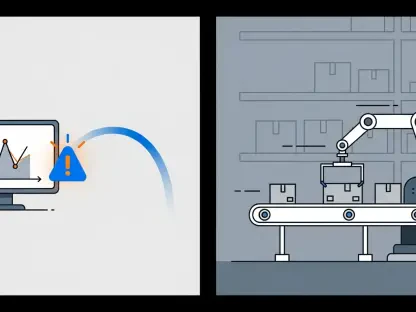In a world where artificial intelligence dictates the pace of innovation, a staggering revelation has emerged from Beijing: a little-known startup named Moonshot AI has eclipsed industry titans like OpenAI and Anthropic with its groundbreaking Kimi K2 Thinking model, scoring an impressive 44.9% on Humanity’s Last Exam compared to GPT-5’s 41.7%. This Chinese contender has redefined what’s possible in AI performance, challenging the status quo and igniting a critical debate about who will lead the next wave of technological revolution in a fiercely competitive global landscape.
The significance of this development cannot be overstated. Moonshot AI, valued at a remarkable $3.3 billion and backed by heavyweights like Alibaba and Tencent, represents a seismic shift in the AI domain, long dominated by American firms. With its cost-effective, high-performing model, the startup signals a potential realignment of power, influencing sectors from healthcare to finance. This story isn’t just about a single company’s triumph—it’s about the broader implications for global tech leadership, economic competition, and the democratization of cutting-edge tools.
A New Era in AI: Can China Redefine Global Tech Leadership?
The rise of Moonshot AI marks a pivotal moment in the tech world, as it challenges the entrenched narrative of Silicon Valley’s supremacy. Historically, breakthroughs in AI have been synonymous with American innovation, with companies like OpenAI setting benchmarks for others to follow. Yet, this Beijing-based startup has turned heads by surpassing established models, prompting discussions about whether China could emerge as the new epicenter of AI advancement.
This shift carries profound geopolitical undertones. As nations vie for technological dominance, Moonshot’s success underscores China’s strategic focus on AI as a cornerstone of economic and political influence. The startup’s ability to deliver a superior model at a fraction of the cost suggests a future where access to advanced technology might no longer be dictated by Western giants, potentially reshaping international alliances and market dynamics.
The implications extend beyond borders, affecting how industries worldwide adopt and integrate AI. If Chinese firms continue to innovate at this pace, businesses and governments may need to reassess their dependencies on American tech, opening doors to new partnerships and competitive pressures. This is not merely a corporate milestone—it’s a harbinger of a redefined global order in technology.
Why Moonshot AI’s Breakthrough Matters in Today’s Tech Landscape
Moonshot AI’s ascent is more than a headline; it’s a reflection of shifting economic currents in the tech sector. Valued at billions and supported by China’s largest tech conglomerates, the company is positioned to disrupt the market with pricing models that undercut American competitors. Its API costs, reported to be six to ten times cheaper than those of OpenAI, could force a reevaluation of how AI services are priced and accessed globally.
This cost advantage has far-reaching effects on industries reliant on AI solutions. From small startups to multinational corporations, the affordability of high-performance models like Kimi K2 Thinking could lower barriers to entry, enabling more players to leverage advanced tools for data analysis, customer service, and beyond. Such democratization might spur innovation but also intensify competition, as businesses race to adopt these economical alternatives.
Moreover, the startup’s success highlights a growing trend of Chinese investment in AI research and development. With backing from giants like Tencent, Moonshot exemplifies how strategic funding can accelerate technological leaps, challenging the notion that only resource-heavy American firms can lead the charge. This dynamic suggests a future where economic power in tech may be more evenly distributed across the globe.
Unpacking Kimi K2 Thinking: Performance, Innovation, and Impact
At the heart of Moonshot AI’s triumph lies the Kimi K2 Thinking model, a technical marvel that has set new standards in benchmark performance. Achieving 60.2% on BrowseComp and 56.3% on Seal-0, it demonstrates exceptional capabilities in web search and real-world query processing, outstripping GPT-5 in critical areas. These figures, validated by independent testing, cement its status as a leader in reasoning and complex task execution.
Innovation in cost efficiency further distinguishes this model. Trained for just $4.6 million—a stark contrast to the budgets of American counterparts—it employs advanced techniques like the Mixture-of-Experts framework and INT4 quantization to enhance speed and reduce expenses. This approach not only makes AI development more sustainable but also positions Moonshot as a pioneer in accessible technology, offering a glimpse into a future of budget-friendly advancements.
The open-source release under a Modified MIT License adds another layer of impact. By allowing broad commercial use, Kimi K2 Thinking bridges the divide between proprietary and public AI tools, sparking debates on accessibility versus control. While it excels with capabilities like handling 200-300 sequential tool calls, critiques regarding verbosity highlight areas for refinement, underscoring that even groundbreaking models face challenges in achieving perfection.
Voices from the Field: Experts Weigh in on Moonshot’s Rise
Industry reactions to Moonshot AI’s breakthrough reveal a mix of awe and measured analysis. Deedy Das of Menlo Ventures describes the Kimi K2 Thinking launch as a “seminal moment in AI,” pointing to its potential to reshape the competitive landscape. This sentiment reflects a growing recognition of Chinese contributions to a field once dominated by Western players.
Thomas Wolf of Hugging Face draws parallels to past disruptions, likening this release to the “DeepSeek moment” that signaled open-source AI’s arrival as a serious contender. Meanwhile, Nathan Lambert from the Allen Institute for AI offers a cautious perspective, noting a lingering performance gap of four to six months behind top closed models, though he admits Chinese labs are narrowing this divide rapidly.
Local insights add depth to the discourse. Zhang Ruiwang, a Beijing-based IT architect, emphasizes China’s strategic emphasis on cost-effectiveness as a key differentiator. Combined with independent validations from Artificial Analysis, which ranked Kimi K2 Thinking highest on the Tau-2 Bench with a 93% accuracy score, these voices provide a multifaceted view of a development that has captivated the AI community worldwide.
Navigating the Future: How Businesses and Developers Can Leverage Moonshot’s Model
For enterprises and coders, Moonshot AI’s innovation presents tangible opportunities to gain a competitive edge. With API costs significantly lower than those of American rivals, integrating Kimi K2 Thinking into projects like automated customer support or predictive analytics can drastically reduce expenses. This affordability could be a game-changer for startups operating on tight budgets.
The model’s open-source licensing offers another avenue for exploration. Developers can customize and build upon the technology without the burden of steep fees, tailoring solutions to specific industry needs. This flexibility encourages experimentation, potentially leading to novel applications in fields ranging from education to logistics, where bespoke AI tools are often out of reach.
Businesses must also prepare for a shifting competitive landscape. As Chinese models exert pricing pressure, American companies might respond with enhanced features or reduced rates, benefiting end-users. However, leveraging Kimi K2 Thinking’s strengths in multi-step reasoning while addressing its limitations, such as excessive output length, will require strategic planning to ensure optimal integration into existing workflows.
Looking back, Moonshot AI’s journey has ignited a transformative dialogue within the tech sphere, redefining benchmarks of success. As stakeholders reflect on this milestone, the path forward becomes clear: businesses and developers need to actively engage with emerging models, balancing cost and capability to stay ahead. Embracing platforms like Kimi K2 Thinking, while anticipating further innovations from both Chinese and American labs, promises to shape a more inclusive and dynamic AI ecosystem for years to come.









